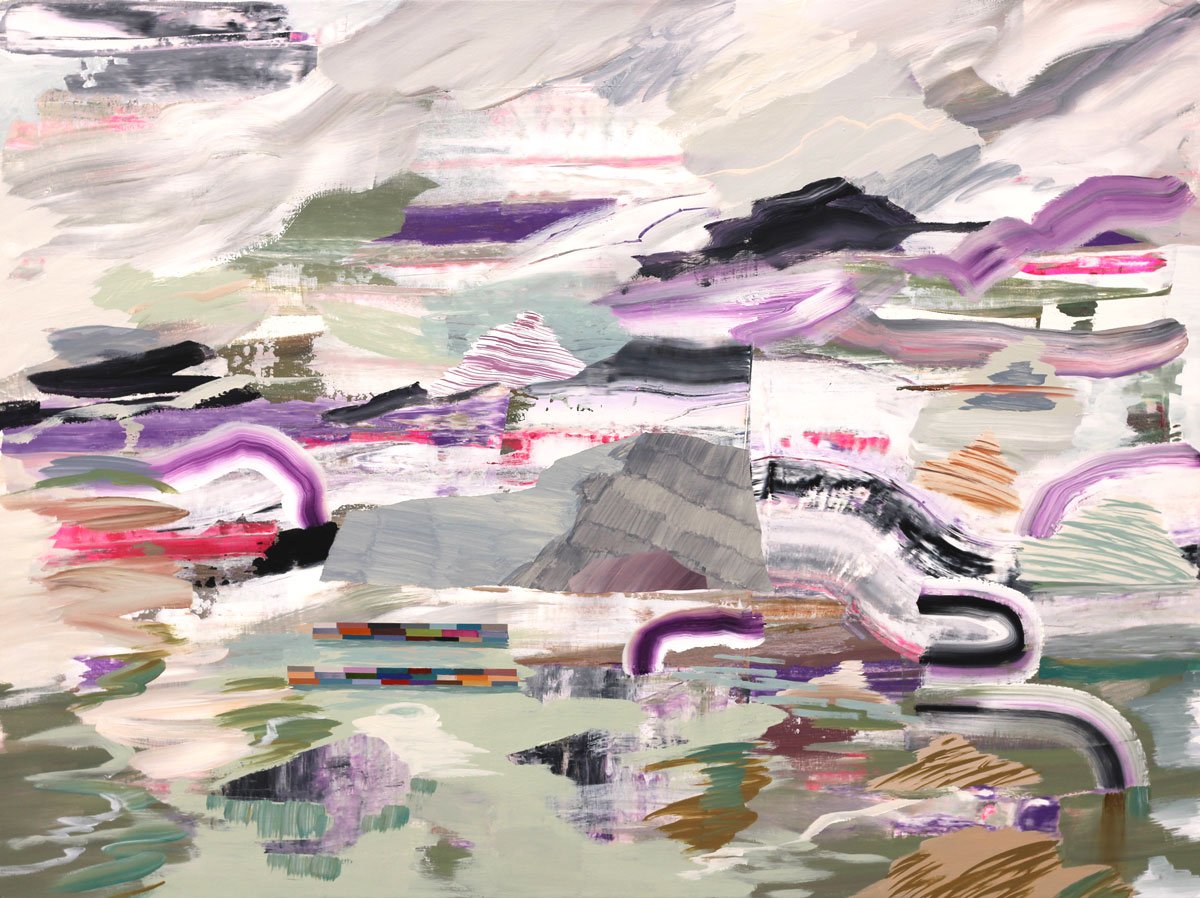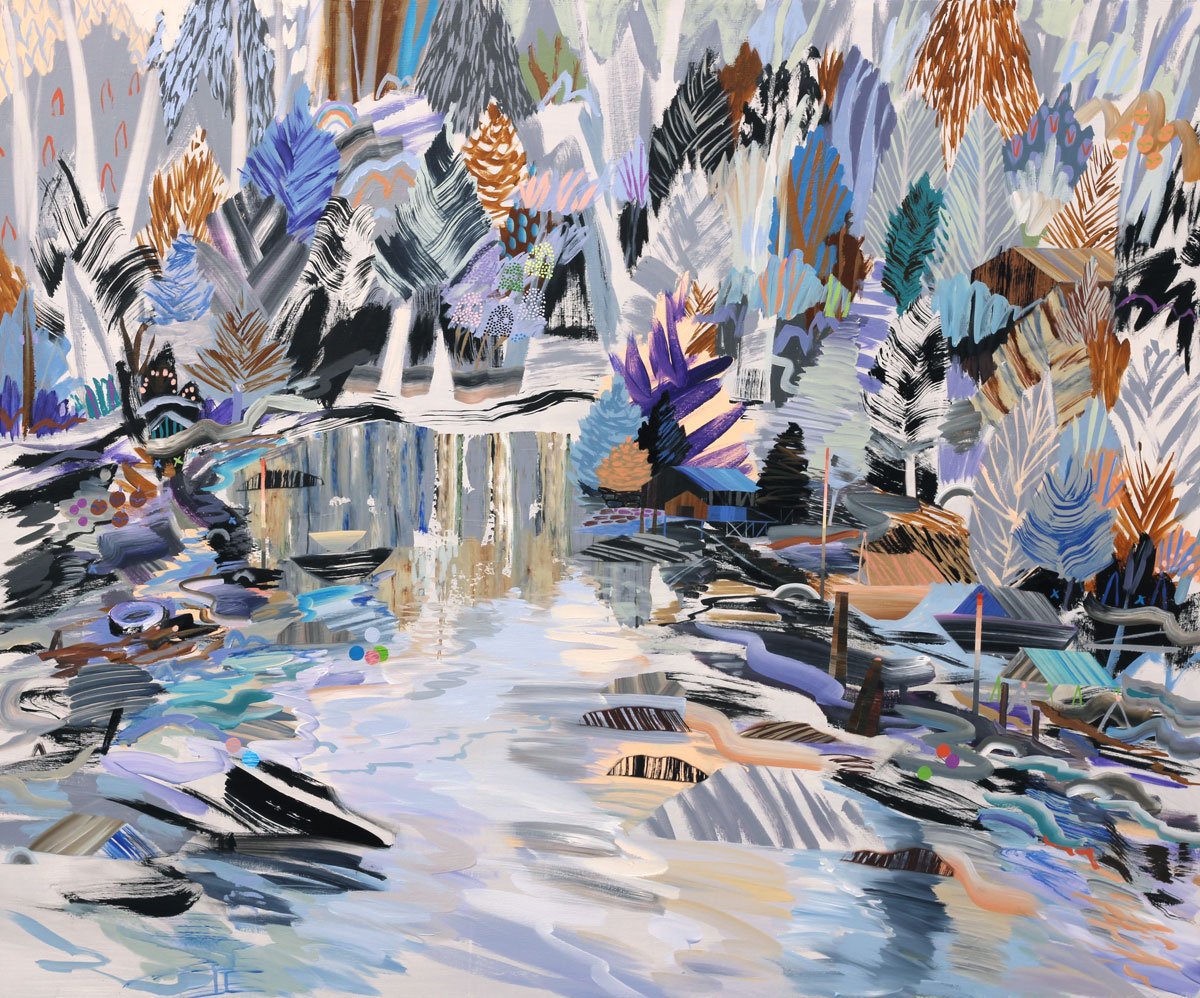“Standing By” explores colourful, dream-like landscapes inspired by communities along the west coast. Cabins on the shore, boats, or logs floating along waterways all serve as anchors, tethering the figurative to the abstract.
Hildebrand explores both familiar and dream-like landscapes. She creates an exciting sense of depth through her use of colour and pattern, where viewers almost hope to push past the colourful foliage and explore what’s beneath. Paradoxically, Hildebrand succeeds in using both maximalist and simplified principles to create worlds within worlds.
Scroll below for a Q&A between Meghan and Madrona Gallery.
Madrona Gallery: Your 2022 exhibition, Changing Channels, saw a greater exploration of landscape and abstraction, an exciting shift from 2019's Pocket Estates. We noticed some of the characters that were in your 2019 exhibition have made a reappearance in The Bunks, a sort of culmination of styles. For this exhibition, what did you want to bring from previous collections of works? What is brand new to this collection?
Meghan Hildebrand: Landscape is a still my jam. In this work I’ve zoomed in on the coastal scenes that were set in Changing Channels. I’m hoping to capture the depth in the tangle of woods beyond the waterline, capture the heady experience of so much visual information that is to look at a forest. I’m setting myself up to do the kind of paintings I love to do, rapid and free-flowing. The piling up of tree shapes lets me see how many ways I can paint a tree, and the surface below waterline offers me another way to paint loosely with a different outcome. I did bring back a few of my painted characters, I think I was curious how they would work with this more naturalistic, and less illustrative (like Pocket Estates) approach. Adding another layer to the collage aspect of my painting style, I’ve intentionally played a bit with scale. Some of the trees are based on drawings of pine cones, making the building shapes appear as tiny models. I really like when paintings begin to unravel the more you look.
MG: There is a greater sense of minimalism in Poetry Research, contrasting with the dense forested landscapes seen in some of the other works. Was there a particular location in mind for this work?
MH: Often in the process of painting a series there is one canvas that gets to be the ’slop’ canvas. When I want to empty the excess paint off a brush or clear a palette, it will go haphazardly onto the slop canvas. Often this is the stage when innovations happen, when there is no attachment to the outcome. In this case I ended up with a beautiful surface reminiscent of marble, white with all kinds of colours dragged through it. I loved it already at that stage and wanted to preserve most of it. I pulled from past work, in that there is an almost cartoonish narrative of simplified shapes. It didn’t need that much visual information to feel like a complete expression to me.
MG: Traplines also picks up on this minimalism and was a stand out piece for us right away. Can you speak more on this piece?
MH: The previous answer largely applies to this one too. I will add that many of the other paintings are so dense, I wanted to offer a rest stop or two. In the case of Traplines, I feel like this one sets the scene which all the paintings are details of. Many of the paintings are intimate, this one is an overview. In this painting I’m loving the expressiveness of loose brushwork and the graphic curved stripes, and I’ve tried to use just a little bit of information to say that it’s a landscape, just a few mountain shapes take you there. Some day I want to pull off a good non-representational painting, this is part of that journey.
MG: For you, what makes a successful painting?
MH: I guess for me it’s down to the basics of colour (I want it to be innovative and interesting as well as harmonious), composition (does it move my eyes around the whole painting), and contrast (would it be dynamic in a black and white photo?). Personally a painting is good to me if I’m breaking new ground and gives me ideas for the next one.
MG: Was there any specific music you were listening to or other routines you had while you were working in the studio?
MH: I’ve been pretty overwhelmed with the state of the world right now and finding it harder to focus in the studio. I’ve found audiobooks and any music with lyrics too distracting, but silence doesn’t work for me either. So I’ve been listening to albums of bird songs. Piano music works too, I’ve been devouring the whole Chilly Gonzales catalogue.











